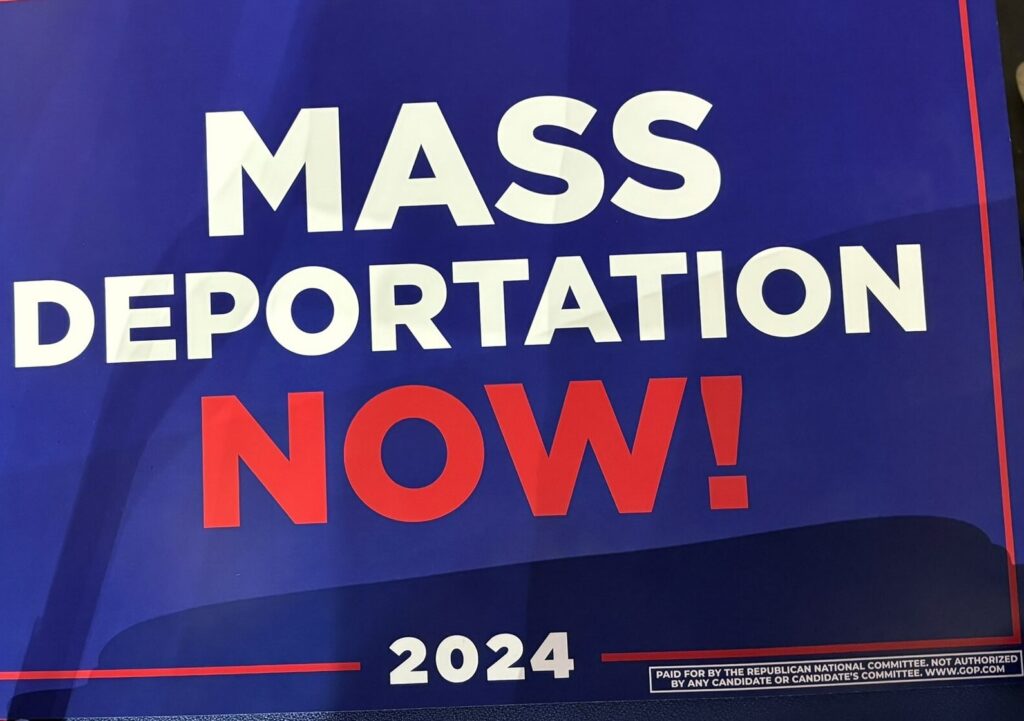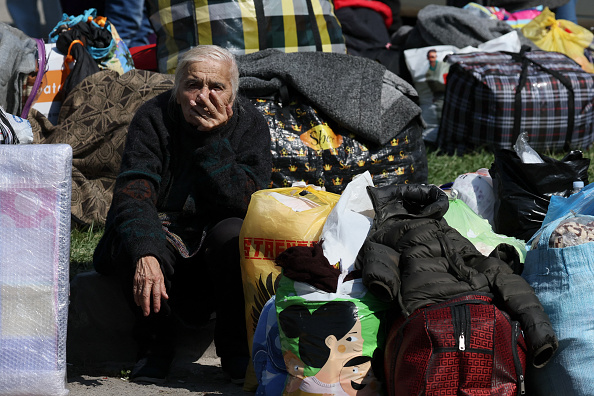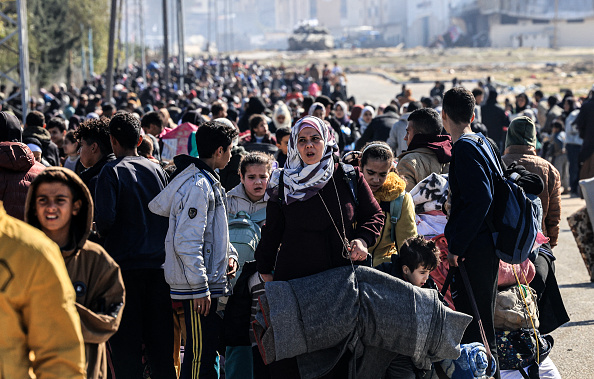The Deportation Delusion
What would it mean to deport 11 million people from the United States?

The “Mass Deportation Now” signs at the Republican National Convention were an enthusiastic endorsement of a radical proposition: Donald Trump has promised “the largest deportation program in American history.” The RNC platform accuses President Joe Biden of overseeing “open-door policies” and inviting a “tidal wave of illegal Aliens, deadly drugs, and Migrant Crime.” Countering this supposed permissiveness, Trump has pledged to “end the invasion at the Southern Border, restore Law and Order, protect American Sovereignty, and deliver a Safe and Prosperous Future for all Americans.”
If “Build the Wall” crystallized Trump’s vision for 2016, his 2024 campaign has made the mass removal of undocumented immigrants its centerpiece. Trump’s advisor on immigration issues, Stephen Miller, has vowed that “Trump will unleash the vast arsenal of federal powers to implement the most spectacular migration crackdown.”
Warning that “murderers” and “rapists” from Mexico were threatening the border when he first announced his bid for the White House, the pivot to expelling millions of people from every corner of the country—including its interior—is a call to see the country besieged, not from without, but from within. In this dark vision, the enemy is no longer looming at the gate. He is now all around us—and must be rooted out. Only after millions are dehumanized, arrested, sent to camps, and then dispatched from the country, can Americans can enjoy peace and prosperity.
It is tempting to dismiss as hyperbole the idea that a second Trump administration would make a priority of rounding up and expelling a population that may number as many as 11 million men, women, and children, nearly 3% of the American population. His “Build the Wall” and “Make Mexico Pay for It” slogans received an electric reception at Trump’s rallies, but the follow-through was haphazard. Trump managed only about 458 miles of wall along a border that stretches more than 1950 miles. Vast gaps remain, and sections of the new construction built under Trump have already crumbled. Meanwhile, desperate people have continued to cross the border.

However, the impact of Trump’s rhetoric cannot be ignored. In 2019, to cite one example, it inspired the shooter who confessed to targeting “Mexicans” at a Walmart in El Paso in 2019, killing 23 people and injuring 22 more. Dehumanizing Mexicans, Central Americans, and other groups, the recent Republican framing of immigration politics has contributed to a climate in which a majority of the American population may back the implementation of a radical approach. In 2025, a more focused Trump White House would likely build upon this groundwork to adopt a sweeping program of mass deportation. What can the past teach us about what we might expect next?
The history of deportations in the US and elsewhere suggests that such an agenda is very possible, but only at extraordinarily high costs. Even if a future Trump administration succeeded in meeting only a portion of its target, a program of mass deportation would have catastrophic consequences for American society and indeed the world.
Deportation Nation
For all of its popularity among MAGA supporters, mass deportation is neither new in American history, nor is it exclusively Republican. Since the 1880s, the US has recorded some 57 million deportations. In addition to formal deportation operations, from the 1920s, local, state, and federal authorities have used informal measures, including the threat of arrest and deportation, to coerce immigrant populations—and Mexicans in particular (citizens and non-citizens alike)—to leave the country. The story of these “fear campaigns” and millions of voluntary departures induced by official scare tactics is reconstructed by Adam Goodman in his book The Deportation Machine.
In 1954, under Dwight D. Eisenhower, the US carried out a mass deportation scheme aimed at undocumented Mexican migrants. The recently created Immigration and Naturalization Service boasted that its “Operation Wetback” deported more than a million unauthorized laborers. A campaign that Trump has cited approvingly as a model for his own plans, this operation targeted Mexican-Americans and Mexicans alike, mostly in Texas and California, but also in non-border locales such as Chicago. While explicitly racist and devastating for an entire generation of people, this policy has since been eclipsed in certain respects.
According to official figures, Bill Clinton deported more than 12 million people, including 1.8 million in 2000 alone. George W. Bush oversaw the deportation of 10 million plus. Castigated by his critics as the “deporter in chief,” Barack Obama deported another five million. During his first term, Trump deported 1.5 million people. Biden is on course to do the same. Since the introduction of Title 42, which cited the pretext of Covid-19 to immediately expel people who crossed the border irregularly from March 2020 to May 2023, the US deported an additional 3 million migrants.
These figures encompass all kinds of deportations regulated by a chaotic jumble of laws—but what Trump appears to envision is a novel approach: a sweeping effort to apprehend and forcibly remove millions of undocumented people, whether they have just arrived at an airport or have lived and worked in this country for a half century or more—whether they overstayed a visa, they themselves crossed the border as adults, or were brought by their parents or someone else as a child. All would bear the same stamp of criminality.
If we take this proposal seriously, it must be understood as the largest policing operation in the history of the country. Deportations on such a scale would entail mass arrests, which would mean a dramatic expansion of wholesale surveillance and, in turn, a sweeping change in how policing works across the US. There would be resistance, and horrible violence would ensue. Families would be separated, lives upended, and children lost–leaving a society at war with itself and sending shockwaves across North and South America.
The False Promise of Deportation
How would a “noncitizen” be identified for deportation? Some 80% of undocumented people have lived in the US for a decade or more. Since most people who are removed from the interior of the country are identified in criminal cases—and given the fact that immigrants and migrants commit crime on a much lower scale than US-born citizens, figuring out who is to be deported would be a monumental—if rarely acknowledged—challenge.
Historically, US Immigrations and Custom Enforcement (ICE) has faced numerous obstacles in identifying people subject to deportation. It has not been uncommon for the agency to mistakenly arrest—and even deport—US citizens. Below the federal level, many jurisdictions have opted not to assist ICE in detaining and deporting people in their communities, recognizing that this practice erodes trust between neighborhoods and law enforcement, compromising public safety. In some jurisdictions, law enforcement has concluded that the ICE agenda conflicts with their own: chasing “illegals” does not advance local police work.
Local authorities also understand that removals are disruptive to the economy and society at large. Thus many states and cities have limited cooperation between ICE and local agencies or declared “sanctuary” status. In recent years, Denver, LA, Chicago, Philadelphia, and other cities have balked at collaborating with ICE. In states where undocumented people can legally obtain drivers licenses, ICE access to DMV databases has been yet another contentious issue.
As a result of these hurdles, ICE has employed new technologies to expand surveillance via social media, public utilities records, facial recognition technology, and databases collected by private, for-profit companies to try to identify people for apprehension. The conservative Heritage Foundation has recently called for integrating schools into this hunt for undocumented people, laying the foundation for policies that would exclude undocumented children from public schools and thus creating pressure on families to “self-deport.”
In a November 2023 interview with the New York Times, Stephen Miller suggested that, under a second Trump administration, ICE would be directed to concentrate on raids and sweeps in public spaces rather than track individual suspects. What Miller has not addressed are the details concerning how ICE will find “illegals.”

It is crucial to note that long before Trump and Miller rhetorically linked immigrant Latinos—as the archetypal “illegal” population—and crime, racial profiling was a well-documented practice among ICE officials and their partners in sheriff departments and other agencies. Should the RNC program of mass deportation prevail, the shadow of suspicion would fall primarily on Latinos.
Yet, as Trump’s “Muslim ban” showed, Muslims would also be vulnerable. In particular, Palestinians—and anyone expressing solidarity with them—could face closer scrutiny, as Miller has boasted in connection with recent anti-genocide protests on college campuses. Among other at-risk groups, Afghans who came to the US following the August 2021 American withdrawal from Afghanistan could also lose their special status and face removal.
Moreover, historically, Black immigrants (from Haiti and numerous African, Caribbean, and South American countries) have faced higher rates of solitary confinement and deportation. They, too, would likely become a focus of enforcement.
Sidestepping how 11 million non-citizens would be pinpointed, Miller has addressed the question of ICE capacity to expand its operations by explaining that the Trump administration would mobilize the National Guard to round up undocumented people. Where “Blue” states might resist committing their units to the task, “Red” states such as Texas would send their forces into states like California to execute the deportation program. Backed by a Trump-friendly Supreme Court, activation of the Insurrection Act might give the White House authority to deploy troops from Texas, for instance, into Los Angeles, San Francisco, or California’s Central Valley. Other ways to work around due process may involve seeking the amorphous cover of “expedited removal” or even the “Alien Enemies Act of 1798.” Beyond raising questions about due process, violations of the Fourth Amendment, the right to privacy, and other fundamental civil rights, such a policy could only be implemented by the threat of violence and the massive use of force.
Should this nation-wide dragnet yield millions of men, women, and children, the US would have to expand its already vast network of detention facilities, which already absorbs roughly half of ICE’s $9.5 billion budget. Unlike in the rest of the US penal system, where only about 8% of prisoners are held in privately run jails and prisons, for-profit immigration detention facilities house 90% of this population on behalf of ICE. To expand this capacity, Miller has said the Trump White House would establish camps “on open land in Texas near the border.” This would be a windfall for companies such as the titans of immigration detention, CoreCivic and the GEO Group.
But it would be a nightmare for “detainees”—people who are, in fact, more aptly called prisoners, who have long complained of mistreatment and abuse in such facilities. Like prisoners elsewhere in the US penal system, this population is subject to solitary confinement and arbitrary treatment, even though as of July 2024, nearly 60% of the 37,000 ICE detainees had no criminal record. (For some with a record, their only blemish is a misdemeanor for the offense of crossing the border irregularly for the first time).
Physicians for Human Rights (PHR) has documented use of solitary confinement in these prisons as a form of torture—noting that several for-profit detention facilities have held people, including those with mental health conditions and suicidal ideation, in solitary confinement for years on end. In one case highlighted by PHR, the Denver Contract Facility sent a person to “the hole” for “eating too slowly.”
Migrant children housed in other institutions have fared no better, as a recent Justice Department suit against the largest provider of housing for unaccompanied minors—and the recipient of some $3 billion in contracts since 2015—has uncovered. There is no reason to think that this gray world of unaccountability would suddenly become more humane were it to expand to take in millions of additional detainees, including children.

This infrastructure of cruelty would have to expand in other ways with mass deportation. Once arrested and confined, millions of people would have to be transferred beyond the borders of the US. But how?
As with facilities run by for-profit corporations, ICE relies on private contractors to coordinate air travel via commercial and charter flights. Typical deportation flights might carry 100 to 200 people at a time. Given this limited capacity, the far more ambitious deportation scheme proposed by Trump’s team would quickly test the capacity of “Ice Air.”
To circumvent this logistical logjam, Trump officials may have to resurrect “The Deportation Express” to borrow the title of Ethan Blue’s book on the Pullman train cars that performed a similar function in the early twentieth century, transporting “undesirable aliens” away from cities across the US. Long essential to cross-border trade, the rail lines connecting the United States and Mexico might be repurposed to transport deportees.
Deportation as Social Engineering
The specter of armed soldiers and police forcing men, women, and children into camps or trains to carry out deportations on the scale imagined by the likes of Trump and Miller inevitably invite comparisons with past episodes of forced migration. In the American context, the violence of the Transatlantic slave trade and the kidnapping of 10-12 million Africans come to mind. Human mobility became a resource in creating a particular kind of society built upon human enslavement. Similarly, between 1830 and 1850, the brutal removal from the southeastern US of some 100,000 Native Americans—Cherokee, Seminole, Muscogee (Creek), Choctaw, and Chickasaw—aimed at consolidating a racial order dominated by white settlers.
Images of express-made detention camps for non-citizens, which would certainly employ the modern version of barbed wire (concertina wire), chaotic train depots, and intimidating canines (already used by several agencies that would be brought to bear) would create associations with the horrors of mass displacement during the Second World War. It would become impossible to ignore the reality that mass deportation is not a question of “following the law”—but of reshaping American society.
As illustrated by Nazis herding Jews, Roma, Sinti, opposition figures, and many other categories of “enemy” onto cattle cars to deport them from the Third Reich and relocate them to occupied territories and concentration camps, mass deportations have historically been about utilizing violence to recalibrate the demographic makeup of a particular population. Immediately after the First World War—and again after the Second, many European states forcibly removed whole populations in the name of consolidating polities that would (they hoped) become nationally and ethnically homogeneous.

Reflecting the same logic, one could point, too, to Soviet policies that violently transported whole populations—Crimean Tatars, Chechens, Ingush, Volga Germans, and others—before, during, and after the Second World War based on the accusation that entire populations had collaborated with the enemy or were ideologically suspect. The compulsory relocation and internment of 100,000 Japanese-Americans during the same period offers yet another cautionary tale about both the ubiquity of this thinking and its utter failure to achieve its avowed aims.
In all of these historic cases, scars remain more than eight decades later. Against this backdrop, we must recognize that questions about verifying one’s residence documents or immigration status can quickly shift to much broader questions about national cohesion and political belonging and violent exclusion.
It is thus essential to recognize that this mass deportation project is not simply about stoking the notion that immigrants compete with citizens for jobs. Despite the horrors of the European world wars, including the mass murder of Jews in the Holocaust and, later, ethnic cleansing in the Balkans and elsewhere, the dream of a monolithic ethnostate persists in the West.
Beyond accusing unauthorized immigrants of “poisoning the blood of our country,” Trump and Miller try to frighten audiences by tying migrants to “Hannibal Lecter,” “insane asylums,” and sexual violence. But the unspoken transcript links the image of a mostly Latino “Other” (sometimes alongside Haitians, Africans, Arabs, and South Asians) to the erosion of white pre-eminence in the US.
When Republican politicians and media dramatize violence committed by non-citizens against American citizens, their invocation of “safety” and “sovereignty” reads as a reminder that “they” are trying to “replace us.” Such thinking has even fueled calls by Trump and others for an end to birthright citizenship, a radical move that would overturn a principle established 156 years ago by the Citizenship Clause of the Fourteenth Amendment–and potentially strip millions of people of their status as US citizens. The “great replacement” anxiety—fear of whites losing their pre-eminence in American society and politics—drives the mass deportation conversation.

The troubling reality is that these associations are effective in shaping public opinion, especially when the ramifications of these slogans remain so vague—and misinformation about migration is so commonplace. Many Americans think “illegal immigration” is the country’s number one problem. According to a June 2024 poll by CBS News/YouGov, 62 percent of registered voters would support “a new national program to deport all undocumented immigrants currently living in the U.S. illegally.”
This logic has roiled politics in the US, Europe, and beyond. The fantasy of a homogeneous nation state—and its construction via population management—is enjoying a global revival. Borders are becoming more and more lethal, from the Mediterranean to the US-Mexico border. Forced migration is not simply about the demography of particular geographic areas in the short term. It is about the fundamental contours of a global order in which violence remains the persistent resource of nationalist politics aimed at a fantasy of majoritarian supremacy.
The Violence of Nativism
In the US context, support for mass deportation rests on groundwork that has been laid over many decades, if not generations. Anti-immigrant rhetoric and symbolism are popular. Trump’s record speaks for itself: calls to shoot migrants and fill moats with alligators and snakes appeal to millions of Americans, not to mention admirers around the globe. His warning that “the Black population is going to die” because of immigration is another remarkable example of how he has used disinformation about migration to pit groups against one another.
What makes such assertions plausible for much of an American electorate is that they are not wholly outside of anything we might call “mainstream.” Biden ran his 2020 campaign against Trump’s wall and immigration language. Once in power, though, he continued wall construction, over the objections of environmental and human rights critics. In 2021, Biden failed to introduce substantive policies to aid Afghans who were displaced by his policies.
And, notably, in June 2024, he tried to boost his electoral campaign by reversing the American commitment to asylum procedures enshrined in international refugee law crafted in response to the Second World War. Vice President Kamala Harris has signaled that, if elected, she would keep in place this sweeping curtailment of migrants’ right to apply for asylum.
A long-standing popular investment in “locking up” and punishing the marginalized and unfamiliar, wielded to date mostly against African Americans, reinforces these aspirations, making them almost common sensical for much of the American electorate. Few American politicians—of either party—have resisted the compulsion to make a scapegoat of migrants, particularly when they can be portrayed as a racial “Other.” This deeply rooted, bipartisan instinct makes Trump’s mass deportation proposition all the more dangerous.
At the same time, mass deportation advocates downplay the violence, human costs, and wide-ranging harm—moral, social, economic, and political—that their plan would inflict on all of American society. Costing tens of billions of dollars to implement, such a project would cripple agriculture in the US (nearly half of all farmworkers are undocumented). Work on construction sites, in restaurants, hotels, and many other businesses would grind to a halt. The economic impact of this disruption would be enormous.
People calling for mass deportation now are drawing the wrong lesson from 1954 when Eisenhower oversaw the deportation of hundreds of thousands of Mexican migrant workers. Employers had to scrambled to replace them with others from Mexico, and workers were pushed into the Bracero Program (1942-1964), a joint US-Mexican agreement that had provided temporary contracts permitting them to work in the US in response to an agricultural labor shortage during the Second World War. It did not end the need for workers from Mexico. US corporations need foreign workers of various kinds, but to date Congress has resisted expanding legal pathways for foreign workers to fill these jobs.
Government budgets would also suffer because, in addition to paying sales and property tax, undocumented workers pay billions of dollars in income tax every year (typically using ITINS—Individual Taxpayer Identification Numbers). In California, they contribute more than $3 billion in state and local taxes, despite being ineligible for many of the services they fund. Nationally, in 2022, they paid nearly $100 billion in taxes.
The notion that deportations are a fix for illegal drugs and the opioid crisis is similarly misguided. The assertion that migrants and asylum-seekers cross the border smuggling fentanyl in their pockets is a myth. More than 90% of fentanyl seizures happen at official border crossings. Nearly all of those convicted of smuggling fentanyl are American citizens. Meanwhile, US border policies have actually played into the hands of cartels and other criminal groups by increasing the insecurity of migrants forced to remain in limbo along the border.
Most important, the human cost of mass deportation would be devastating. In the wake of the violence that would be necessary to execute any such program, mixed-status families (in which one or more members are undocumented) would be separated and deprived of breadwinners. For minors who are US citizens but whose parents are undocumented, the loss of one or more parents would be catastrophic. Moreover, many people brought to the US as young children would be deported to countries that they scarcely know.
This last aspect is another factor that deportation campaigners have not come to terms with. In addition to many domestic logistical impediments, the Trump administration would have to negotiate agreements with states willing to accept deportees. They would primarily have to convince Mexico and a host of other countries in Latin America to absorb these populations.
Mexico’s most deprived communities would have to forego the $63 billion in remittances that workers sent in 2023, and repatriated migrants would then be expected to ignore the conditions that compelled them (or their families) to leave these countries in the first place. Historically, Mexican migration has been circular. Many deportees would simply return—or others would follow in their initial footsteps to the US.
Mass deportation from the US would only deepen political instability and economic hardship in these countries. Repatriation efforts would place a significant burden on these societies, and it is not clear what their effects might be.
The history of the notorious criminal organization MS-13 (Mara Salvatrucha) is but one example of the complex effects of deportation and repatriation. Born in the 1980s in Los Angeles among young refugees fleeing violence in Central America, it expanded only in the 1990s in El Salvador and across Central America after the Clinton administration carried out mass deportations of suspected members. The group went on to destabilize El Salvador, in particular. Violence perpetrated by MS-13 and state security forces have since been a constant factor in forcing people to seek refuge in the US.
Combined with the worsening effects of the climate crisis, multiple forces are thus very likely to continue to spur migration from the across the Global South. Ignorance of these dynamics and how Washington’s policies exacerbate them have long plagued debates about how to create a more just and humane legal framework for migration.
Other American policies work at cross purposes as well. Economic sanctions aimed at punishing Washington’s political foes have devastated economies in places like Venezuela, driving people toward the United States. Republican calls for military intervention in Mexico, amplified by Trump and his vice-presidential nominee JD Vance, in the name of combating drug cartels provide another example of a policy that would surely increase irregular migration across the southern border; the chaos and bloodshed that would ensue from the further escalation of the US-Mexico drug war—one fueled by American guns and demand for drugs—could displace millions more civilians.
Promising voters that the US could invade Mexico while simultaneously seeking to deport millions of undocumented people back to Mexico and its neighbors is the height of delusion. But it is not to be dismissed lightly.
Mass deportation must be resisted at the ballot box. Should its backers prevail, though, the rest of American society must be prepared to mobilize to block it. In addition to challenging this agenda in the public square and in the courts, we must prepare for mass civil disobedience and collectively devise other measures to prevent a dystopian future built upon violence and ignorance of the past.
Robert D. Crews is Professor of History at Stanford University.



